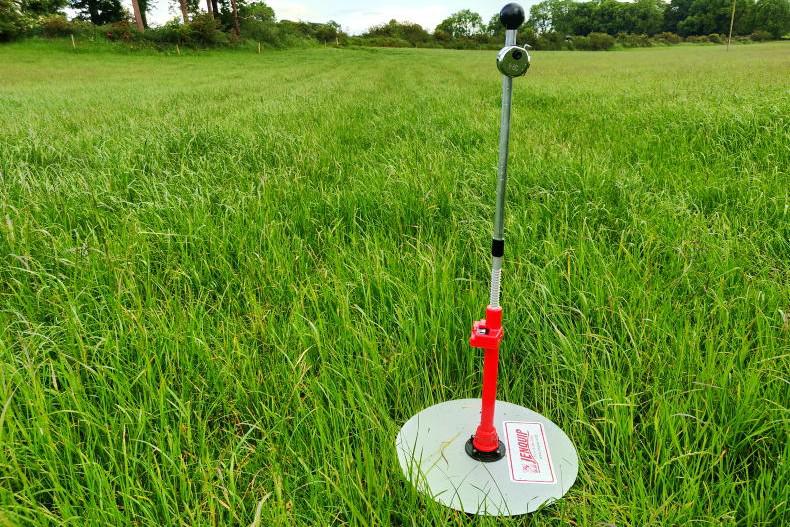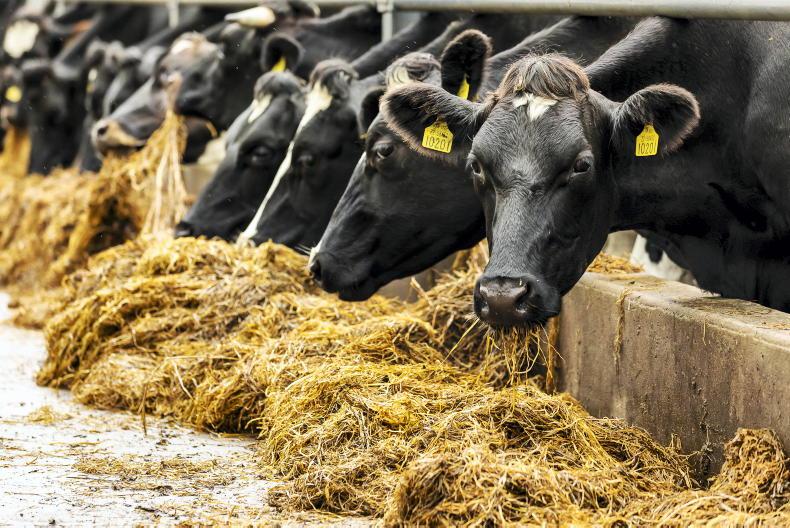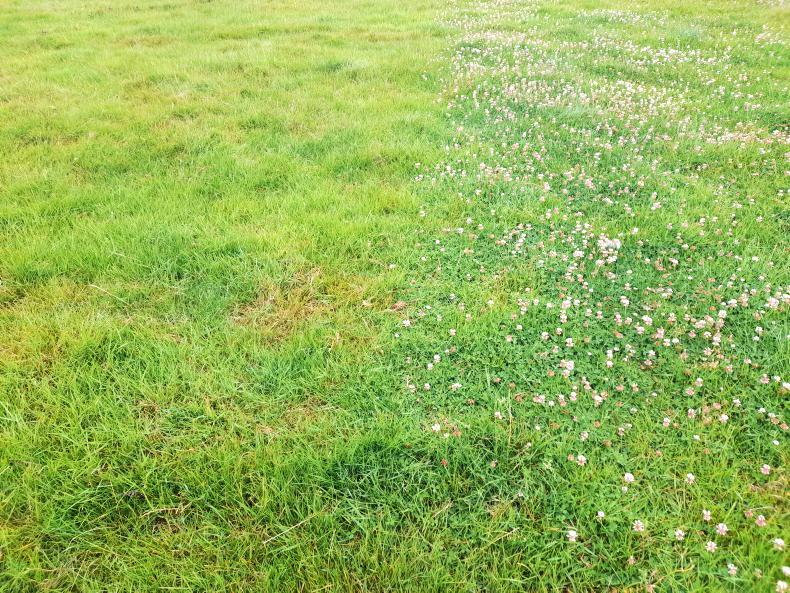Not all clover is the same and more emphasis needs to be placed on choosing good varieties, according to Goldcrop’s Patrick Cashman. He says there is as much as a 2t DM/ha yield difference between clover varieties in trials at Moorepark.
Looking at the 2025 recommended lists, there is over 1t DM/ha yield difference between the top and bottom clover variety and something similar between grass varieties, so it is clearly important to focus on clover as well as grass when choosing varieties for reseeding.
Cashman was speaking at a Goldcrop event in Teagasc Grange recently, where the main topic of conversation was clover varieties, specifically new white clover varieties Clodagh and Dungloe and red clover variety Fearga.
Patrick says there is a step change taking place with clover variety selection with new Teagasc bred varieties Clodagh and Dungloe way out in front of everything else on the market: “The results of our partnership with the Teagasc breeding programme at Oak Park is really delivering now. Clodagh is about 10% ahead and Dungloe is 6% ahead in terms of yield, meaning farmers that grow these varieties will have more feed on their farm.
“They’ve also got better seasonality of production, meaning the higher yield is distributed more evenly across the growing season, which is important. Both Clodagh and Dungloe are the highest performers in the UK and French recommended lists too which gives us great confidence about their suitability across different soil types and rainfall levels”, he says.
Biological N fixation
Patrick says that yield is not only important from a feed yield point of view, but also for its ability to reduce nitrogen use as biological N fixation is directly linked to the yield of clover.
Patrick says that both Clodagh and Dungloe are just the first of ten new white clover varieties bred by Teagasc that will be on the recommended lists over the coming years. He says two more varieties will be on the list next year, with “each one better than the next”.
Clodagh and Dungloe will only be available as part of mixtures in 2025, so will not be available for over-sowing this spring.
Red clover trial
Teagasc have been carrying out research on red clover at both Moorepark and Grange using eight red clover varieties and three nitrogen fertiliser rates. The trial is carried out in plots which are cut to simulate a silage harvest.

Peter Doyle at the red clover plots at Teagasc Grange.
The plots were sown in May 2022 with red clover sown at a rate of 4kg/acre along with 10kg/acre of perennial ryegrass containing Gracehill and Astonconquerer.
The plots are being evaluated under three nitrogen protocols; 0kg N/ha, 75kg N/ha and 150kg N/ha and are cut three times per year at a 6cm cutting height. All of the plots receive the same level of phosphorus and potash with 35kg P/ha and 350kg K/ha applied over the course of the growing season.
The eight red clover varieties being assessed are Aberclaret, Fearga, Spurt, Sinope, Amos, Pastour, Garant and Bonus.
Annual dry matter yield and percentage of red clover in the plots are being assessed by Teagasc Walsh Fellow Sinead Kearney.
After two full growing seasons, there is a considerable visual difference between the plots at Grange, with some of the plots with far less red clover present than others. Perennial ryegrass was sown alongside the red clover but where the red clover has died out, extra space has been created for weeds.
High yields
Due to the fact that red clover can fix up to 250kg N/ha annually, where there is less red clover in a plot, there is a greater yield penalty in the entire plot. In other words, getting red clover to survive is the first step towards achieving high yields.
According to the researchers, dry matter yield reduced in the second growing season compared to the first growing season for all varieties. The researchers say that they will need at least three years of data to adequately assess the impact of persistency on yield, but there are already strong indicators that some varieties are more persistent than others.
The best performing varieties in terms of yield and clover content are Aberclaret and Fearga red clover. These are both growing over 14.5t DM/ha across the two years and have average red clover contents at 70% or more.
Spurt, Sinope, Amos and Pastour are mid-ranking, growing in the region of 13t to 13.5t DM/ha annually and have clover contents of approximately 60%. Both Garrant and Bonus are the worst performing after two years of the trial, growing about 12t DM/ha and they have the lowest clover content at 50% and 45% respectively.
Response to nitrogen
Importantly, the trial is showing a strong response to applied nitrogen for the first cut. The average yield response to nitrogen was an extra 894kg DM/ha to the first cut but there was no response to nitrogen in the subsequent cuts.
This stands to reason as clover contents increase as the season goes on, so applying nitrogen when there is already plenty of nitrogen available doesn’t make sense. Its also important to note that where nitrogen was applied, it was split across three applications. For the 75kg N/ha treatment the rates were 33kg N/ha for first cut, 25kg N/ha for second cut and 14kg N/ha for the third cut.
For the 150kg N/ha treatment, there was 66kg N/ha applied in the first cut, 50kg N/ha in second cut and 27kg N/ha in the third cut. There was no yield response to the higher rates of nitrogen at the first cut.
So based on the first two years of this trial, the advice to spread up to 33kg N/ha for the first cut would appear to be sound. Of course, this would typically be delivered if say 3,000 gallons/acre of slurry was being spread in advance of cutting.
The Derrypatrick herd at Grange is carrying out systems research on clover under suckler beef and beef finishing regimes.
There are two elements to the study, lead by Teagasc researcher Peter Doyle. The first element involves yearling steers and heifers assigned to a grass only or grass and white clover sward in spring and finished in October at 19 months of age.
The cattle grazing the white clover swards had greater average daily gain of 0.1kg head/day during the grazing season resulting in a 27kg heavier liveweight and 14kg heavier carcass weight at the end of the grazing season.
For the second experiment, calves were assigned to either a grass-only or a grass and clover treatment from birth and were followed through to slaughter at 19 months of age. The ones on the clover treatment were grazing grass and white clover swards when grazing and fed red clover silage when housed.
Liveweight difference
There was a 10kg liveweight difference in favour of the grass and clover treatment at weaning and a 13kg difference at housing. The difference grew over the winter period when the animals on the clover treatment were fed red clover silage and by turnout they were 27kg heavier.
Interestingly, there was no increase in performance over and above the grass only treatment in the second grazing season and the difference in weight at slaughter was 27kg. However, Peter points out that only one cycle of animals have gone through yet with the second and third cycle being reared now.

White clover and grass swards at the Derrypatrick farm in Grange.
The fact that the animals in the two-year study didn’t show a difference in performance in the second grazing season is a contrast to the first study, where clover delivered a boost to liveweight. If this was replicated in the longer study, the animals on the clover treatment would be 54kg heavier.
Peter says that one of the reasons for this could be that the animals on the red clover silage have higher intakes of good-quality silage but that this then reduces the impact of compensatory growth while at grass.
Nitrogen rates
In terms of nitrogen rates, the grass and clover treatments received 75kg N/ha while the grass only treatments received 150kg N/ha annually. Grass growth was the same between both treatment at 12t DM/ha and both treatments were stocked at 2.2 livestock units/ha or 170kg organic N/ha.
New white clover varieties Clodagh and Dungloe are showing significant yield gains on other varieties.The best-performing varieties in terms of yield and clover content at Teagasc trials are Aberclaret and Fearga red clover.Cattle grazing white clover swards during the second grazing season at Derrypatrick had 27kg heavier liveweight at slaughter.
Not all clover is the same and more emphasis needs to be placed on choosing good varieties, according to Goldcrop’s Patrick Cashman. He says there is as much as a 2t DM/ha yield difference between clover varieties in trials at Moorepark.
Looking at the 2025 recommended lists, there is over 1t DM/ha yield difference between the top and bottom clover variety and something similar between grass varieties, so it is clearly important to focus on clover as well as grass when choosing varieties for reseeding.
Cashman was speaking at a Goldcrop event in Teagasc Grange recently, where the main topic of conversation was clover varieties, specifically new white clover varieties Clodagh and Dungloe and red clover variety Fearga.
Patrick says there is a step change taking place with clover variety selection with new Teagasc bred varieties Clodagh and Dungloe way out in front of everything else on the market: “The results of our partnership with the Teagasc breeding programme at Oak Park is really delivering now. Clodagh is about 10% ahead and Dungloe is 6% ahead in terms of yield, meaning farmers that grow these varieties will have more feed on their farm.
“They’ve also got better seasonality of production, meaning the higher yield is distributed more evenly across the growing season, which is important. Both Clodagh and Dungloe are the highest performers in the UK and French recommended lists too which gives us great confidence about their suitability across different soil types and rainfall levels”, he says.
Biological N fixation
Patrick says that yield is not only important from a feed yield point of view, but also for its ability to reduce nitrogen use as biological N fixation is directly linked to the yield of clover.
Patrick says that both Clodagh and Dungloe are just the first of ten new white clover varieties bred by Teagasc that will be on the recommended lists over the coming years. He says two more varieties will be on the list next year, with “each one better than the next”.
Clodagh and Dungloe will only be available as part of mixtures in 2025, so will not be available for over-sowing this spring.
Red clover trial
Teagasc have been carrying out research on red clover at both Moorepark and Grange using eight red clover varieties and three nitrogen fertiliser rates. The trial is carried out in plots which are cut to simulate a silage harvest.

Peter Doyle at the red clover plots at Teagasc Grange.
The plots were sown in May 2022 with red clover sown at a rate of 4kg/acre along with 10kg/acre of perennial ryegrass containing Gracehill and Astonconquerer.
The plots are being evaluated under three nitrogen protocols; 0kg N/ha, 75kg N/ha and 150kg N/ha and are cut three times per year at a 6cm cutting height. All of the plots receive the same level of phosphorus and potash with 35kg P/ha and 350kg K/ha applied over the course of the growing season.
The eight red clover varieties being assessed are Aberclaret, Fearga, Spurt, Sinope, Amos, Pastour, Garant and Bonus.
Annual dry matter yield and percentage of red clover in the plots are being assessed by Teagasc Walsh Fellow Sinead Kearney.
After two full growing seasons, there is a considerable visual difference between the plots at Grange, with some of the plots with far less red clover present than others. Perennial ryegrass was sown alongside the red clover but where the red clover has died out, extra space has been created for weeds.
High yields
Due to the fact that red clover can fix up to 250kg N/ha annually, where there is less red clover in a plot, there is a greater yield penalty in the entire plot. In other words, getting red clover to survive is the first step towards achieving high yields.
According to the researchers, dry matter yield reduced in the second growing season compared to the first growing season for all varieties. The researchers say that they will need at least three years of data to adequately assess the impact of persistency on yield, but there are already strong indicators that some varieties are more persistent than others.
The best performing varieties in terms of yield and clover content are Aberclaret and Fearga red clover. These are both growing over 14.5t DM/ha across the two years and have average red clover contents at 70% or more.
Spurt, Sinope, Amos and Pastour are mid-ranking, growing in the region of 13t to 13.5t DM/ha annually and have clover contents of approximately 60%. Both Garrant and Bonus are the worst performing after two years of the trial, growing about 12t DM/ha and they have the lowest clover content at 50% and 45% respectively.
Response to nitrogen
Importantly, the trial is showing a strong response to applied nitrogen for the first cut. The average yield response to nitrogen was an extra 894kg DM/ha to the first cut but there was no response to nitrogen in the subsequent cuts.
This stands to reason as clover contents increase as the season goes on, so applying nitrogen when there is already plenty of nitrogen available doesn’t make sense. Its also important to note that where nitrogen was applied, it was split across three applications. For the 75kg N/ha treatment the rates were 33kg N/ha for first cut, 25kg N/ha for second cut and 14kg N/ha for the third cut.
For the 150kg N/ha treatment, there was 66kg N/ha applied in the first cut, 50kg N/ha in second cut and 27kg N/ha in the third cut. There was no yield response to the higher rates of nitrogen at the first cut.
So based on the first two years of this trial, the advice to spread up to 33kg N/ha for the first cut would appear to be sound. Of course, this would typically be delivered if say 3,000 gallons/acre of slurry was being spread in advance of cutting.
The Derrypatrick herd at Grange is carrying out systems research on clover under suckler beef and beef finishing regimes.
There are two elements to the study, lead by Teagasc researcher Peter Doyle. The first element involves yearling steers and heifers assigned to a grass only or grass and white clover sward in spring and finished in October at 19 months of age.
The cattle grazing the white clover swards had greater average daily gain of 0.1kg head/day during the grazing season resulting in a 27kg heavier liveweight and 14kg heavier carcass weight at the end of the grazing season.
For the second experiment, calves were assigned to either a grass-only or a grass and clover treatment from birth and were followed through to slaughter at 19 months of age. The ones on the clover treatment were grazing grass and white clover swards when grazing and fed red clover silage when housed.
Liveweight difference
There was a 10kg liveweight difference in favour of the grass and clover treatment at weaning and a 13kg difference at housing. The difference grew over the winter period when the animals on the clover treatment were fed red clover silage and by turnout they were 27kg heavier.
Interestingly, there was no increase in performance over and above the grass only treatment in the second grazing season and the difference in weight at slaughter was 27kg. However, Peter points out that only one cycle of animals have gone through yet with the second and third cycle being reared now.

White clover and grass swards at the Derrypatrick farm in Grange.
The fact that the animals in the two-year study didn’t show a difference in performance in the second grazing season is a contrast to the first study, where clover delivered a boost to liveweight. If this was replicated in the longer study, the animals on the clover treatment would be 54kg heavier.
Peter says that one of the reasons for this could be that the animals on the red clover silage have higher intakes of good-quality silage but that this then reduces the impact of compensatory growth while at grass.
Nitrogen rates
In terms of nitrogen rates, the grass and clover treatments received 75kg N/ha while the grass only treatments received 150kg N/ha annually. Grass growth was the same between both treatment at 12t DM/ha and both treatments were stocked at 2.2 livestock units/ha or 170kg organic N/ha.
New white clover varieties Clodagh and Dungloe are showing significant yield gains on other varieties.The best-performing varieties in terms of yield and clover content at Teagasc trials are Aberclaret and Fearga red clover.Cattle grazing white clover swards during the second grazing season at Derrypatrick had 27kg heavier liveweight at slaughter. 










SHARING OPTIONS